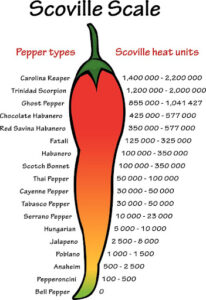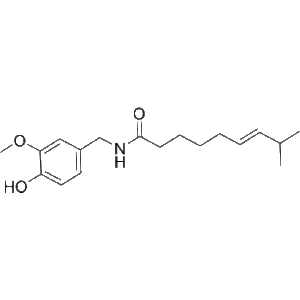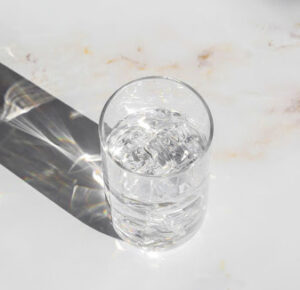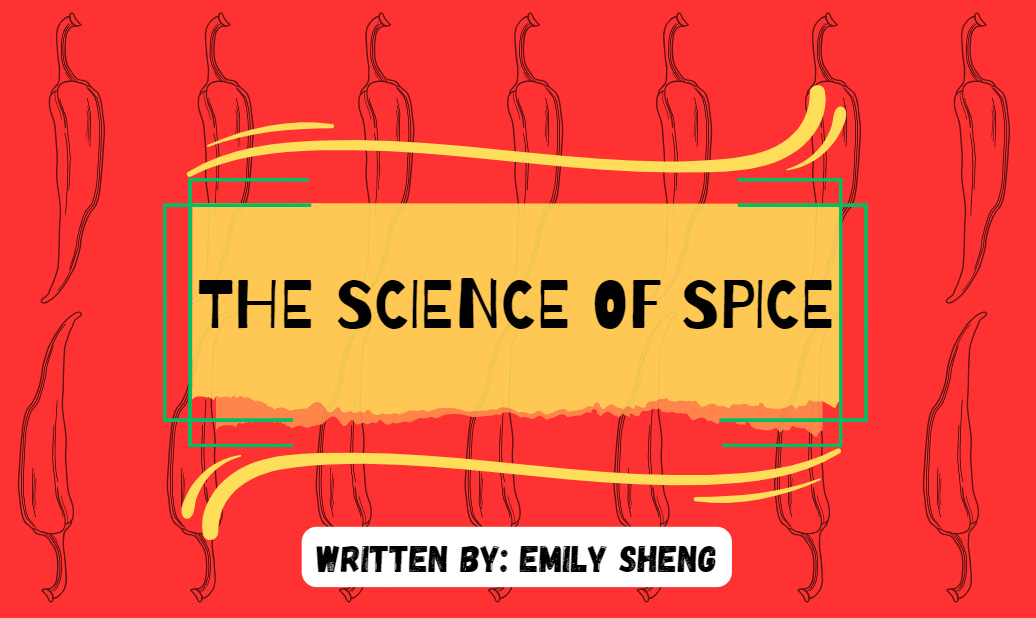Written by: Emily Sheng
Edited by: Julia Georgescu
Designed by: Maahi Jain
Published by: Maryam Khan

The hot, burning sensation of chili pepper can entice some people and ward others away. Whether it makes your mouth feel like a summer beach vacation or a bubbling chasm of eternal fire, it has been a popular way to spice up all sorts of dishes for millennia. But how exactly can peppers create that intense heat in your mouth? Is it producing heat when you consume it, or is it just tricking you into thinking that there is a mini volcano erupting every time you bite down on a pepper? It’s time to find out!
The Culprit of the Spice
Well, as it turns out, many peppers use a simple and effective way to generate spiciness. Introducing a neat  little chemical called capsaicin! Capsaicin is an organic compound that is found in chili peppers, and it is responsible for the spiciness of peppers. Chili peppers come from a genus of plants called Capsicum, and all peppers from this genus will have varying amounts of capsaicin. The Scoville scale is used to measure the spiciness of different peppers based on the concentration of capsaicin that’s found in each pepper type. Bell peppers have the lowest ranking with 0 scoville heat units because they contain no capsaicin at all, while pure capsaicin is ranked the highest with around 16,000,000 scoville heat units.
little chemical called capsaicin! Capsaicin is an organic compound that is found in chili peppers, and it is responsible for the spiciness of peppers. Chili peppers come from a genus of plants called Capsicum, and all peppers from this genus will have varying amounts of capsaicin. The Scoville scale is used to measure the spiciness of different peppers based on the concentration of capsaicin that’s found in each pepper type. Bell peppers have the lowest ranking with 0 scoville heat units because they contain no capsaicin at all, while pure capsaicin is ranked the highest with around 16,000,000 scoville heat units.
Origins of Capsaicin
 Capsaicin is thought to be an evolutionary line of defense for protecting the seeds of chili peppers from hungry animals. When animals consume the seeds, they can get damaged throughout the digestion process, which prevents the seed from germinating and producing a new generation of pepper plants. This is why it is the most concentrated near the center of the pepper, where all the seeds grow.
Capsaicin is thought to be an evolutionary line of defense for protecting the seeds of chili peppers from hungry animals. When animals consume the seeds, they can get damaged throughout the digestion process, which prevents the seed from germinating and producing a new generation of pepper plants. This is why it is the most concentrated near the center of the pepper, where all the seeds grow.
Interestingly enough, birds are not affected by capsaicin and can happily gain the nutritional benefits of chili peppers without experiencing its fiery side effects. Unlike mammals, the digestive system of birds is less damaging to the pepper seeds, so the birds can help disperse the seeds for germination.
So how does it work?
 Capsaicin’s chemical name is 8-Methyl-N-vanillyl-trans-6-nonenamide, and it belongs to a family of compounds known as capsaicinoids. This entire family can generate spicy flavor, but the capsaicin compound is the most prominent within chili peppers.
Capsaicin’s chemical name is 8-Methyl-N-vanillyl-trans-6-nonenamide, and it belongs to a family of compounds known as capsaicinoids. This entire family can generate spicy flavor, but the capsaicin compound is the most prominent within chili peppers.
When consumed, this chemical can bind to a type of receptor in the mouth called TRPV1. This receptor is connected to the nervous system and can send signals of pain to the brain when it senses high temperatures in the mouth. When capsaicin binds to TRPV1, the receptor interprets it as a high temperature and triggers a burning and abrasive sensation. It is similar to touching something hot and feeling the burn from it, except capsaicin does not cause damage to the mouth.
Other foods like black peppers, wasabi, and horseradish utilize a similar mechanic except with a different compound.
Spice Desensitization
Can we train ourselves to become less sensitive to spicy foods? The answer is yes! When capsaicin activates TRPV1 often, the receptor will less frequently send pain signals to the brain, becoming “desensitized” to spicy foods. This is why those who often eat spicy foods don’t feel the heat as much.
Extinguishing the Fire
 For those who break a sweat from the sight of spicy foods, fear not, for there are simple remedies for relieving the heat.
For those who break a sweat from the sight of spicy foods, fear not, for there are simple remedies for relieving the heat.
Unlike what many people say, drinking water is an instant no! The structure of capsaicin is largely hydrophobic, meaning it will not dissolve in water. Although the initial surge of cool water can feel like respite, the water will only spread the capsaicin out over an even larger area and bring back the burn.
A surprising method that doesn’t completely eradicate the spice, but greatly eliminates some of it is blocking your nose. Whether it’s with nose plugs or another method, preventing inhalation through the nose can help, as even inhaling capsaicin can cause irritation.
Fats and sugars are a great way to surround capsaicin and negate its effects. Since capsaicin is lipophilic, it can readily dissolve in fats and oils, which makes it unable to bind to receptors once dissolved. Sugar can also help overpower the spiciness with sweetness, which can distract your brain a little bit from the burn.
Acidic foods can also help reduce the heat because acidic foods like lemon or lime have low pHs, while capsaicin has a higher pH, therefore the acid can help neutralize some of the capsaicin.
With all of this in mind, a key lime pie is an excellent effective method for staving off spice as it checks off most of the boxes for offsetting capsaicin. It contains fat from dairy, it has sugar, it gets its acidity from the limes, and the thick paste-like consistency of the pie allows it to coat the inside of your mouth and provide long-lasting remedial effects.
of the boxes for offsetting capsaicin. It contains fat from dairy, it has sugar, it gets its acidity from the limes, and the thick paste-like consistency of the pie allows it to coat the inside of your mouth and provide long-lasting remedial effects.
It’s crazy how one tiny compound can burn such an inferno! Now, the next time you face off against such a formidable foe, you have enough knowledge to conquer the spice once and for all!
References
Can You Be Desensitized to Spicy Food? (n.d.). Cayenne Diane. Retrieved July 2, 2023, from https://www.cayennediane.com/can-you-be-desensitized-to-spicy-food/
Capsaicin: Current Understanding of Its Mechanisms and Therapy of Pain and Other Pre-Clinical and Clinical Uses. (n.d.). NCBI. Retrieved July 2, 2023, from https://www.ncbi.nlm.nih.gov/pmc/articles/PMC6273101/
Farr, K. (2019, May 3). The Scoville Rating Scale. MySpicer.com. Retrieved July 2, 2023, from https://www.myspicer.com/scoville-rating-scale/
The Food Theorists. (2020, October 1). Food Theory: How To SURVIVE Spicy Food! (Hot Ones Challenge). YouTube. Retrieved July 2, 2023, from https://www.youtube.com/watch?v=v0So51Q6GLg&ab_channel=TheFoodTheorists
VanAlphen, B. (2014, January 15). Why Chilli Peppers are Spicy: The Chemistry of a Chilli. Compound Interest. Retrieved July 2, 2023, from https://www.compoundchem.com/2014/01/15/why-chilli-peppers-are-spicy-the-chemistry-of-a-chilli/
What are Capsaicinoids and Capsaicin? (n.d.). Cayenne Diane. Retrieved July 2, 2023, from https://www.cayennediane.com/what-are-capsaicinoids/
What makes food spicy? (2017, September 22). Food Republic. Retrieved July 2, 2023, from https://www.foodrepublic.com/2011/05/11/what-makes-food-spicy/
What Makes Hot Peppers Spicy? (n.d.). Cayenne Diane. Retrieved July 2, 2023, from https://www.cayennediane.com/what-makes-hot-peppers-spicy/
Photo sources (In order of appearance):
Photo by Timothy L Brock on Unsplash
https://www.myspicer.com/scoville-rating-scale/
Photo by Jeppe Vadgaard on Unsplash
https://www.medchemexpress.com/Capsaicin.html
Photo by Giorgio Trovato on Unsplash
Photo by Takuya Nagaoka on Unsplash

